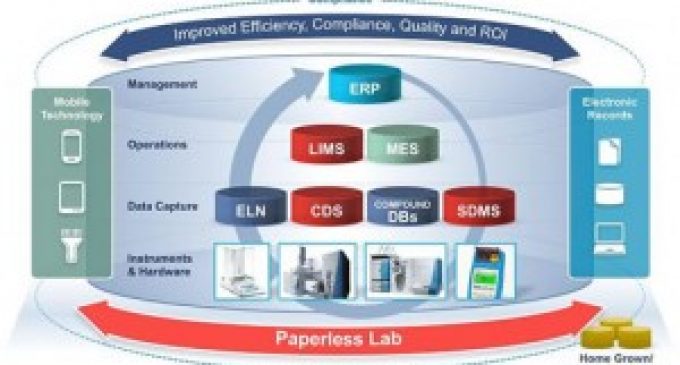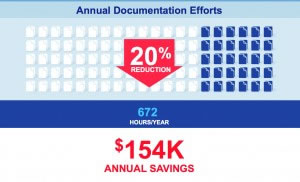The Four Pillars that Will Transform the Food and Beverage Industry

By Colin Thurston, Director of Product Strategy, Process Industries, Thermo Fisher Scientific
External forces are now rapidly conspiring to unravel even the best-laid plans of food manufacturers. From geopolitical and economic macro trends to major shifts in regulations such as the Food Safety Modernization Act (FSMA) to public pressure to deliver on brand promises, change in this industry is now maddeningly unpredictable and capricious. Without a proactive plan to address these new realities, some food producers are in for challenging times.
The good news is that many established companies in the food and beverage industry have spent more than two decades methodically adding technology in preparation for this transformation. But all this investment could be for naught unless companies make an historic stand to strategically align non-integrated, often widely distributed resources in ways that enable maximum agility. Over the next decade, we will see massive shifts in the way businesses approach investment, expansion, R&D spending, human resources and other critical drivers of growth.
Despite delays due to sequestration, the looming FSMA in the U.S. still forces food and beverage companies to consider investments in innovation, improvements in governance and, of course, new compliance and reporting capabilities that span the entire supply chain. Similarly, strict regulations placed on food companies producing in or exporting to Europe only stand to become more rigorous in the wake of the region’s horsemeat scandal. In large companies, for whom international expansion is a top priority, these developments can profoundly impact the bottom line.
What has all this to do with labs and laboratory management? Everything. To push the boundaries of innovation, companies in the food and beverage industry must assiduously monitor performance and quality and be ready to capitalize on every opportunity to transform and grow. For today’s elite companies, there are four drivers of constant business transformation: integration, innovation, automation and business intelligence. When all four drivers are in sync, business transformation isn’t just a strategy anymore; instead it’s a state of being.
Why is it so important for food manufacturers to be perpetually “business transformation-ready?” Because many of the most exciting opportunities to expand business and capture new market share are unpredictable and temporal. Consider large multinational brands such as Coca-Cola and Heineken. As they reach into emerging economies in Asia and Latin America, for example, they face immediate challenges such as conforming to local laws whilst also harmonizing new operations with existing geographies to remain as lean as possible.
Adding to the complexities of expansion is the constant pull of technology. And for a lab of any size, new technologies go well beyond instrument advancements alone; cloud and mobile computing, for example, are driving major changes that not only affect business velocity, but also lower entry barriers to increasing numbers of competitors. In this way, technology is an enabling catalyst that puts even more pressure on laboratories and managers to stay ahead.
But technology is only a means to an end: data. Data is the currency of business, especially in the lab, and business transformation is inexorably linked to effective data management. Even with the best laboratory instruments and information technology infrastructure in place, there is often little difference between solutions. It is how the data is managed and applied across the enterprise to create business intelligence that becomes the unique competitive advantage.
Food and beverage businesses today must have full visibility into laboratory operations and create strategies to make new insights actionable. A one-day head-start diagnosing an issue with raw materials in the supply chain or recalling shipments of tainted product could save millions. In other words, the benefits of agile decision-making are not trivial – bottom-line and top-line revenue as well as the value of the brand, hangs in the balance. This is why it’s so important for food producers to regard a laboratory information management system (LIMS) as much more than just a data collection solution for the lab; it’s an operating system for business transformation.

Because LIMS are tightly integrated with other enterprise operation systems such as ERP, insights from the lab have the potential to be even more central to businesses seeking true enterprise-wide agility. Food manufacturers aren’t simply capturing and collecting data; they are making data actionable, putting management in position to transform their businesses into agile enterprises capable of responding quickly to market trends or new regulations (such as the FSMA) and flexible enough to recognize and capitalize on cost-saving or margin-growing opportunities in the future.
Once again, the agile food and beverage company, one that is truly business transformation-ready, must rest on a platform that is supported by four pillars: integration, innovation, automation and business intelligence. The good news is that many food producers have some semblance of these pillars already, so final alignment is less onerous than many realize. But the time to get started is now.
o Innovation – Innovation is tightly aligned with information. A lab driven by data insight – not just instrumentation – is able to discover avenues for innovation that exist only in a macro view. From improved food quality to more efficient ways to manufacture product, liberating laboratory data in dashboard form can be a new catalyst for continuous change. And the ability to recognize and exploit pathways for innovation is as much cultural as it is process-oriented. When employees become accustomed to seeing a bigger picture – through data – business transformation becomes a cultural norm, not a discrete initiative.
o Automation – Time is an ally of discovery. When staff can devote more of it to innovation, great things happen. Automating time-consuming tasks such as instrument calibration, compliance, reporting, user training and maintenance liberates more time for new ideas and improved decision making, investing this perishable intellectual capital back into business transformation. As businesses turn to new markets and just-in-time product innovation to compete, the ability to automate processes will become one of the most important characteristics of a business transformation-ready food company.
o Business Intelligence (BI) – Many food and beverage organizations declare success once they’ve acquired the ability to quickly and efficiently collect, store and organize knowledge. To be truly business transformation-ready, however, companies must use BI to do more than organize; they must insist on action. In many enterprises, if a manager or executive wants to see laboratory progress or productivity reports, for example, the IT department has to step in. Given this extra step, few executives take advantage of the rich data that surrounds them. Today, however, thanks to more mature BI approaches enabled by cloud computing, lab personnel can create real-time dashboard reports that are accessible to managers and executives 24/7 via desktop, tablet or mobile device. Critical information is available to decision-makers in a few clicks. This laboratory data is mission critical inside any food manufacturer that relies on analytical testing for quality assurance, consistency and compliance today and profitable product innovation in the future.
A technology roadmap now exists for building a business transformation-ready food and beverage company. When data is presented to decision-makers logically and intuitively, it fuels new strategic growth, and it does so with unprecedented agility. The first step, however, is liberating hidden insights that are stored in laboratories around the world, enabling more smart people to proactively query and use vast stores of knowledge. When that happens, a business is truly transformed, its laboratory is a growth driver, management is fully engaged and investors and consumers couldn’t be happier.


































